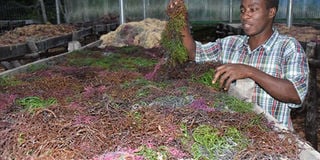To make shampoo and soap, we farm in ocean

Mohammed Nasoro, Kibuyuni Seaweed Farmers project coordinator shows some of the harvested seaweeds. PHOTO |FILE
What you need to know:
Nasoro is now a seaweed farmer, and together with other villagers, they have formed Kibuyuni seaweed group, through which they make soaps, soap noodles and oil and shampoos from the sea algae.
With marine life plummeting by the day, coastal communities that initially depended on the Indian Ocean for money, employment and food are increasingly becoming vulnerable and frustrated, forcing them to look for alternative livelihoods.
- Besides filling the fisheries gap, cultivating seaweed is widely perceived as one of the most environmentally friendly types of aquaculture, as it does not require additional feed or fertilisers.
Sometime in late 1990s, Nasoro Mohammed joined the fishing industry; then the trade was promising as the daily catch was big.
Fishing was the backbone of his Kibuyuni village as it fed and employed several locals and their families.
"But that is no longer the case and we have to change with the tide,” he said at KICC, Nairobi recently, where Seeds of Gold met him during the blue economy conference.
Nasoro is now a seaweed farmer, and together with other villagers, they have formed Kibuyuni seaweed group, through which they make soaps, soap noodles and oil and shampoos from the sea algae.
With marine life plummeting by the day, coastal communities that initially depended on the Indian Ocean for money, employment and food are increasingly becoming vulnerable and frustrated, forcing them to look for alternative livelihoods.
Besides filling the fisheries gap, cultivating seaweed is widely perceived as one of the most environmentally friendly types of aquaculture, as it does not require additional feed or fertilisers.
Nasoro survived as a fisherman for over a decade before quitting the trade in 2007 due to dwindling fish stocks.
About that time, seaweed farming was catching up in Kibuyuni, so he joined the algae farming bandwagon to make ends meet.
Kibuyuni Seaweed Farmers group has 125 members — 70 women and 55 men — who not only grow and sell dried seaweeds but have also invested in seaweed value addition.
“We have benefited a great deal from the venture. Two months ago we sold 93 tonnes of the weed and made Sh2 million,” said Nasoro, the project coordinator, adding that the farming has offered many of them a new lifeline.
Group marketing
While the weeds are marketed through the group, every farmer has their own block where they grow and tend the weeds to maturity. Once harvested, the weeds are dried and aggregated at a centre for sale.
The group, which primarily works as a farmers’ co-operative, enables members achieve the bulk needed by the buyer.
“Even though the blocks are owned by individual farmers, we encourage them to involve their families in the farming to minimise workload,” Nasoro said.
The weed is vegetatively propagated so farmers replant part of their harvest.
Others get seedlings from Kenya Marine and Fisheries Research Institute (Kemfri) at the Coast.
Introduced in the Island of Zanzibar in 1988, seaweed farming has grown into an industry offering sustainable employment in developing and emerging economies. Zanzibar is currently the East African market for the weeds.
The idea of seaweed farming was introduced to the Kenyan coastal communities by Kemfri in 2006.
Farmers were trained and empowered to grow the seaweeds of the eucheumoid algae varieties.
Fatuma Mohammed, the chairperson of the Kibuyuni group, explains that to grow the weed, it is tied in a straight rope that can hold 49-50 seedlings at ago on the seabed.
Unlike growing crops on land where inputs such as fertilisers and pesticides are required, seaweed farming only needs the ocean water. Once planted, the weeds mature after 45 days.
Close monitoring
Close monitoring is also done to clean and tighten the ropes as well as replace those washed away or unhooked by tides.
“Harvesting is done by ripping off mature weeds from the ropes and loading them for drying in an open space for about three to four days,” said Mohammed, adding that other than cosmetics, fresh weeds can be used as food salads or for making juice.
Nasoro says soap making involves mixing water, ground seaweed powder, coconut oil, caustic soda and essential oils, a work which is done using a machine.

Nasoro Mohammed displaying soaps made from sea weeds. PHOTO |LEOPOLD OBI| NMG
“Those involved in soap-making must be thorough trained so that they know the right proportions to use.”
They sell a kilo of the weed at Sh22 to a Tanzanian firm known as Zanzibar Seaweed Corporation and a soap at Sh150.
However, the farmers noted that back in 2015, a kilo of the weeds sold at Sh30 a kilo, but the prices have dropped lately.
Last month, Fatuma harvested and sold three tonnes of the weeds at Sh22.
“Our biggest challenge is the market for our cosmetics. We are yet to break even as much as we are trying to push our products,” she said.
Medicinal properties
Patrick Mathendu, a researcher at Kemfri, noted that seaweed soaps have medicinal properties that help smoothen and heal the skin.
Other than their economical use, the weeds which can grow rapidly and efficiently, provide plant-based proteins and show promise as a source of biofuel to replace fossil fuels.
Nutritionally, the weeds are a good source of omega 3 and vitamins A, C, E and K, along with folate, zinc, sodium, calcium and magnesium.
Gabriel Rugalema, Food and Agriculture Organisation country director, says they are keen to provide technical and financial support to different countries to support fisheries and blue economy.
“We have been working with farmers in Mombasa, Kilifi and Kwale counties to harness ocean fish farming, crabs and shrimp farming, milk fish farming as well as seaweed farming,” Rugalema said.





